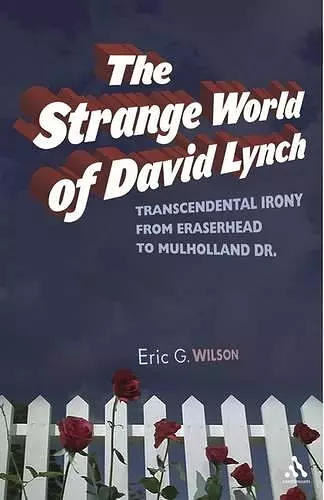The Strange World of David Lynch
Transcendental Irony from Eraserhead to Mulholland Dr.
Format:Paperback
Publisher:Bloomsbury Publishing PLC
Published:30th Jul '07
Currently unavailable, and unfortunately no date known when it will be back

David Lynch's films pull us into a strange world where reality turns upside down and sideways. This book illuminates not only Lynch's film but also the study of religion and film by showing that the most profound cinematic experiences of religion have very little to do with traditional belief systems.Anyone who has watched "Twin Peaks" or sat through the dark and grainy world of "Eraserhead" knows that David Lynch's films pull us into a strange world where reality turns upside down and sideways. His films are carnivals that allow us to transcend our ordinary lives and to reverse the meanings we live with in our daily lives. Nowhere is this demonstrated better than in the opening scene of "Blue Velvet" when our worlds are literally turned on their ears. Lynch endlessly vacillates between Hollywood conventions and avant-garde experimentation, placing viewers in the awkward position of not knowing when the image is serious and when it's in jest, when meaning is lucid or when it's lost. In this way, his style places form and content in a perpetually self-consuming dialogue. But what do Lynch's films have to do with religion? Wilson attempts to answer that question in his book. To say that irony (especially of the kind found in Lynch's films) generates religious experience is to suggest religion can be founded on nihilism. Moreover, in claiming Lynch's films are religious, one must assume that extremely violent and lurid sexual films are somehow expressions of energies of peace, tranquility and love. Wilson illuminates not only Lynch's film but also the study of religion and film by showing that the most profound cinematic experiences of religion have very little to do with traditional belief systems. His book offers fresh ways of connecting the cinematic image to the sacred experience.
Eric G. Wilson quotes Rosselini's remark in The Strange World of David Lynch: Transcendental Irony from Eraserhead to Mullholand Drive, which locates a wealth of spiritual meanings, connotations, and implications in five Lynch films. Wilson isn't the first scholar to look at Lynch in religious terms but he may be the most thoroughgoing and inventive. Nobody is suggesting that the pictures at hand—all utterly original, hugely audacious, and fearlessly bizarre—are Methodist Allegories, evangelical screeds, or coded Rosicrucian messages. What they do add up to, Wilson argues, is a body of "sacred "secular cinema" informed by a radical religiosity that enables Lynch to avoid two common philosophical mistakes: dualism, which divides the world into opposites like good-evil and order-chaos, and monism, which reduces the cosmos to some undifferentiated unity- all is material, all is spiritual, all is whatever. Lynch has pursued an open- ended journey into what Wilson calls transcendental irony, appearance and reality, creation and destruction, desire and fulfillment, nature and artifice, conscious and unconscious, form and formlessness, and all the multifaceted "antinomies of existence" of which a sensitively attunes spirit is exhilaratingly aware. ...Wilson throws in Transcendental Meditation, which Lynch learned from Maharishi Mahesh Yogi, the mantra-chanting guru who enlightened the Beatles a few decades ago. Lynch inconveniently insists that his films have nothing to do with religion, but this doesn't slow Wilson down for a second. It's just a neat example of the "earnest playfulness" that makes Lynch so, well, Lynchian. ‘I don't mean to be facetious but if I do sound that way, chalk it up to the persuasive power of Wilson's own arguments, which are too serious to take themselves too seriously. A critic who admires Lynch for dodging the traps of monistic and dualistic thinking can't afford to fall into those very pitfalls, and since cinema scholarship spends a good deal of its time down there, Wilson wisely staves off error by deploying a film-theoretical version of earnest playfulness. In the introduction to his book, for instance, he lays out the ideas I've outlined and plausible applies them to scenes in Lynch movies. Whatever you think of Wilson's overall approach, you have to be charmed by his good-natured candor and respect for ambiguity, which lend wonder and surprise to his analyses of enigmas, aporias, and impossibilities in Lynch's films. Wilson's book was finished before Lynch completed Inland Empire, that may well stand as his very greatest work. Unfazed as always by empirical "reality," Wilson writes about the picture anyway, predicting that it will explore "the imperial interiors that stay forever unmapped," sounding "the abmysal insides of the heart" to their profoundest depths. You read it right, folks: Wilson has written one of that film's most astute descriptions without seeing a single frame. It seems his ridiculous hermeneutics are just what's needed for opening our eyed to a mystical "third term" surpassing the divide " between many and one , chaos and order—a barely possible thing as lurid and gorgeous as Blue Velvet wavering in the muted light." -- popmatters.com
ISBN: 9780826428240
Dimensions: unknown
Weight: 256g
192 pages